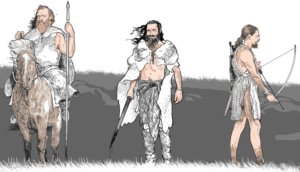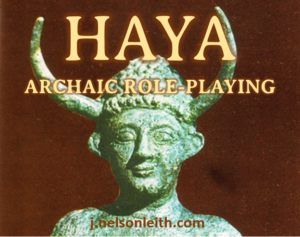 Basics
Basics
This sketched out campaign is a spectrum of what in our world would be called the Ice Age (Stone Age) and the Bronze Age: prehistoric monsters, archaic demihumans, megalithic chiefdoms, and wealthy city-states. The landscape is filled with elemental Spirit Folk, the gods speak to priests at the top of high temples, warriors meet in single heroic combat between gathered armies, and scribes records histories, rituals, and lore on magical stone tablets called chronicle stones.
In the Stone-Bronze Age world of Haya the stones and metals, both precious and martial, are conceived of a bit differently from those in our own world. See the section titled The Three Worlds and the Elements for details.
The setting is purposefully system-neutral in mechanics, but loosely references the d20 System in order to accommodate a good number of gamers.
It is designed for thoughtful players wanting a tough, low-level campaign where the player characters (PCs) are outliers constantly struggling against greater forces and where nature and the divine are always more powerful than mortals, to keep “regular folk” (i.e., the PCs) engaged in thinking their way through adventures. So, in d20 terms, PCs are capped at level 10, with non-player characters (NPCs) capped at level 15. Referees (DMs) should be stingy with the experience.
Archaisms and Overview
Despite that the game setting the players will primarily experience being a Bronze Age world, the peripheries of that world exhibit many archaisms from previous epochs of the Cenozoic Era.
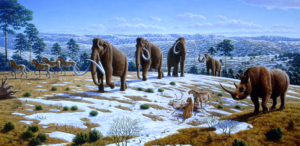 The Far North. The northern edge of Haya, under the wall of the Great Ice, is much like the Earth in the Pleistocene.
The Far North. The northern edge of Haya, under the wall of the Great Ice, is much like the Earth in the Pleistocene.
A vast steppe of grasslands and lakes with groves of hardy trees here and there, host mammoths, woolly rhinos, giant bison, wild horses, and shovel-tuskers, hunted by dire wolves, giant polar bears, cave hyena, and sabre-toothed cats. The lakes and braided rivers of the north are home to three-meter long salmon, giant beavers, and river seals. Short, stocky demihuman races similar to the Neanderthals and Denisovans live as nomadic hunters, while monstrous humanoids called Ohti, similar to ogres or hill giants, dwell in remote gorges.
The mountain-ringed forests of the west are haunts of giant deer, mastodons, cave bears, and cave lions. The streams there teem with huge salmon, giant catfish, enormous eels, and freshwater squid. Stone Age humans hunt the forest and paint magical images on the walls of their caverns. The coniferous forests of the middle north are the home to mastodon, giant deer, short-faced bears, and giant otters. Gold-haired Stone Age humans dwell in treehouses and carve sacred symbols on stones and tree trunks. The temperate forest of the east is the haunt of a demihuman race similar to Home erectus, a huge brown-and-black striped tiger, and sky-beasts similar to Baluchitherium.
Elemental Spirit Folk (similar to elemental and fey monsters) control the natural resources of the far north and the landscape is dotted with holy sites, rock outcrops and groves, where humans and demihumans commune with the gods or Spirit Folk.
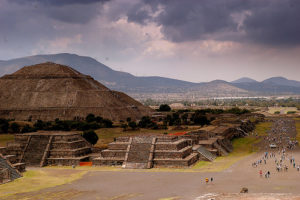 The Far South. The southern shores, under the sands of the Great Waste, form a long coast of subtropical woodlands and deserts of dust and rock, separated by two rugged mountain ranges into three distinct lands.
The Far South. The southern shores, under the sands of the Great Waste, form a long coast of subtropical woodlands and deserts of dust and rock, separated by two rugged mountain ranges into three distinct lands.
In the far south-east, the Stone Age humans live a nomadic life hunting jangi (kangaroo) in the deserts and woodlands, under constant threat by huge flightless birds called ru’e, lion-like giant wombats, enormous spiders, and massive constrictors. In the central south, a demihuman race similar to Homo ergaster thrives in a dusty scrubland plagued by giant monitor lizards and huge scorpions. In the far south-west, humans live as Stone Age farmers, nomadic herders and hunters, and in the Bronze Age kingdom of Zemed, among hoe-tuskers, white camels, huge baboons, giant cheetahs, black lions, monstrous hippos, and giant crocodiles.
Elemental Spirit Folk haunt the wilds of the south, as well as giant humanoids called Ezolites who indenture themselves to humans in exchange for food, monstrosities like sphinxes and basilisks, and constructs similar to golems.
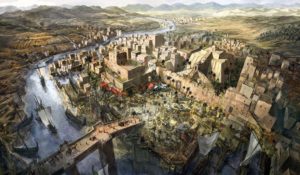 The Civilized Realm. The seas between the north and south, where literate humans live, are the home of giant sharks like Megalodon, huge serpentine whales like Zeuglodon, and enormous cephalopods. The coastal realms are home to elephants, hoe-tuskers, lions, wolves, bears. Each island also hosts endemic beasts and monsters, like minotaurs, nagas, huge lizards, enormous predatory birds, and indigenous humanoids.
The Civilized Realm. The seas between the north and south, where literate humans live, are the home of giant sharks like Megalodon, huge serpentine whales like Zeuglodon, and enormous cephalopods. The coastal realms are home to elephants, hoe-tuskers, lions, wolves, bears. Each island also hosts endemic beasts and monsters, like minotaurs, nagas, huge lizards, enormous predatory birds, and indigenous humanoids.
The giant, furry Peyu live in the glacial plateau above Hallia, the mountains to the east of Addaz, and the high forested valley of Zasai. The red-furred Matamhi, a highly evolved version of orangutan, live among the jungle tree of Zasai, Wesadhi, and Yasayoi. Fanged and copper-skinned Zhydh live as marauders on unsettled shores from Tydhemia to the western seas.
Diminutive archaic peoples haunt in the uplands of the Yuta and Adya, driven there by the expansion of civilized people and forming close ties to the Spirit Folk. The curly, black-haired and yellow-skinned Razu Old People live in the interior of Zotti, Shattem, Divesh, and Inet, trading with the towns and cities along the shore. The Tsote Flower People, known for curly hair with stripes of blond, brown, and red, live among the Matamhi in the jungles of the eastern islands, fiercely protecting their upland valleys from the humans on the coasts.
The True People, who recognize each other as human—dark-skinned, dark-haired, and dark-eyed—contend with animistic Spirit Folk occupying all unsettled regions, as well as divinely created monstrosities and magical constructs. Most of the True People’s tribes are Stone Age peoples, but many also enjoy the Gift of Bronze.
For the True People, the primary PC races, the world is a complex cornucopia of subtle urban political intrigue, secretive Priestly orders and their capricious gods, seaborne smuggling and piracy, imperial warfare, ancient dungeon-crawling, struggles with otherworldly Spirit Folk, the threat of deadly monsters, the joy of Poets and taverns and brothels, and the wild perils of the untamed frontiers of civilization.
The Three Worlds and the Elements
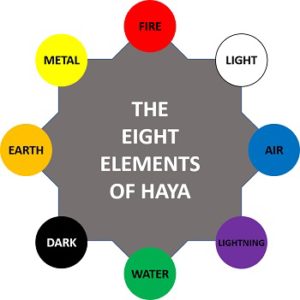
Original graphic.
Humans live in the Gray World, the mortal realm where all elements are mixed. The gods live in the Pure World, an eight-fold realm divided among the elements and characterized by pure colors. These gods are vaguely defined, and different cults combine or differentiate them in various ways. For those with knowledge of different cultures, it is unclear what the true nature of the gods is, although many suspect they are like the elements, standing alone in purity but also mixing in their joint Creation.
Between the two worlds of mortals and the gods is the Half World of the Spirit Races, each of which represent one of the eight elements. The three worlds overlap so that humans, Spirit Races, and the gods may interact.
The eight elements and their representations in the Three Worlds are as follows. The names of the elements are in the stone language (the archaic tongue of the oldest chronicle stones) of the humans called the Tower People or Yuta.
Each element has a unique metal from its admixture with elemental metal (or metal’s purity to itself), as well as a gem from its weak admixture with stone (or stone’s purity to itself) and a “stone” from its strong admixture with stone (or stone’s admixture with a balance of all other elements). All gems are precious, but metals and stones are divided among precious and utilitarian varieties.
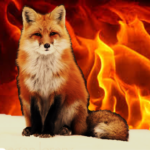 Fire (kupur) Represented by red, the fox, and the holly tree, the element of fire is embodied in the Spirit Race known as kupuri. The kupuri are loosely associated with the sun, but more strongly tied to the campfire, the hearth, and the smithy. They often appear as red-furred or flame-engulfed humans, and have a reputation for being both easily tamed but also dangerous when unleashed.
Fire (kupur) Represented by red, the fox, and the holly tree, the element of fire is embodied in the Spirit Race known as kupuri. The kupuri are loosely associated with the sun, but more strongly tied to the campfire, the hearth, and the smithy. They often appear as red-furred or flame-engulfed humans, and have a reputation for being both easily tamed but also dangerous when unleashed.
The fire metal, copper or kupurum, is a precious metal (worth one-fifth of silver/argenitum) that also combines with tin, sitanum, to create utilitarian bronze. Copper itself is the bane of the afa, Spirit Folk of water.
The fire stone, kuprite, is a martial stone similar to real-world flint but reddish in color, a stone which can also be used to create fire. The fire gem, kuprube or ruby, is a red jewel.
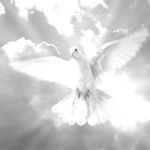 Light (argenit) Represented by white, the dove, and the magnolia tree, the element of light is embodied in the Spirit Race known as argenti, pronounced with a hard G. The argenti are strongly associated with the sun, enlightenment, life, and knowledge. They appear as white-winged and white-skinned humans, and have a reputation for being generally helpful.
Light (argenit) Represented by white, the dove, and the magnolia tree, the element of light is embodied in the Spirit Race known as argenti, pronounced with a hard G. The argenti are strongly associated with the sun, enlightenment, life, and knowledge. They appear as white-winged and white-skinned humans, and have a reputation for being generally helpful.
The light metal, silver or argenitum, is a precious metal (worth one-fifth of gold/aurum) that is the bane of the hrusi Spirit Folk of dark, and is plated onto weapons designed to fight the hrusi.
The light stone, argenite or chalk, is useful in dying and marking things. The light gem, diamond or argebe, is a clear or whitish jewel.
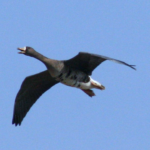 Air (gai-ti) Represented by blue, the tallwood tree (similar to the redwood), and the sky goose, which has bluish wing feathers, the element of air is embodied in the Spirit Race known as tia. The tia are associated with the cardinal directions from which winds blow, and have a reputation for being capricious. They appear as blue-winged and blue-skinned humans, and are greatly revered by sailors, of course.
Air (gai-ti) Represented by blue, the tallwood tree (similar to the redwood), and the sky goose, which has bluish wing feathers, the element of air is embodied in the Spirit Race known as tia. The tia are associated with the cardinal directions from which winds blow, and have a reputation for being capricious. They appear as blue-winged and blue-skinned humans, and are greatly revered by sailors, of course.
The air metal, gaitium, is a bluish metal that is light but weak, and generally considered useless as either a precious or martial metal. It is, however, useful in air-based magic.
The air stone, gaitite, a blue marble-like stone, is highly prized for sculpture, but rare. The air gem, sapphire or tibe, is a blue jewel.
 Lightning (fere) Represented by purple, the royal eagle, and the oak tree, the element of lightning is embodied in the Spirit Race known as ferei. The ferei appear as purple-skinned humans, often cloaked in electric arcs, and are considered unpredictable and fierce, allies of the most violent of the tia and afa as collaborators in destructive storms.
Lightning (fere) Represented by purple, the royal eagle, and the oak tree, the element of lightning is embodied in the Spirit Race known as ferei. The ferei appear as purple-skinned humans, often cloaked in electric arcs, and are considered unpredictable and fierce, allies of the most violent of the tia and afa as collaborators in destructive storms.
The lightning metal, iron or fereum, is a strong metal that is hard to forge due to its resistance to fire, and thus rarely used except in weapons specifically designed to attack the auri Spirit Folk of metal, against whom iron is a bane.
The lightning stone, fereite, is a purplish basalt-like building stone. The lightning gem, amethyst or ferebe, is a purple jewel.
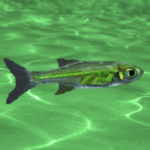 Water (mai-af) Represented by green, kelp, and fish, the element of water is embodied in the Spirit Race known as afa. The afa have three tribes: the pure afa of freshwater, who protect springs, streams, and falls; the low afa of salt water, who live in the seas; and the high afa of vegetation, who protect grasslands, bushes, and trees that draw water toward the sky. The pure afa appear as green-skinned humans, the low afa as half-human and half-dolphin, and the high afa as green-skinned humans with vegetation for hair.
Water (mai-af) Represented by green, kelp, and fish, the element of water is embodied in the Spirit Race known as afa. The afa have three tribes: the pure afa of freshwater, who protect springs, streams, and falls; the low afa of salt water, who live in the seas; and the high afa of vegetation, who protect grasslands, bushes, and trees that draw water toward the sky. The pure afa appear as green-skinned humans, the low afa as half-human and half-dolphin, and the high afa as green-skinned humans with vegetation for hair.
The water metal, maium, is a greenish metal that is weak and generally considered useless as either a precious or martial metal. It is, however, useful in water-based magic.
The water stone, afite or jade, is a precious stone highly valued in carving. The water gem, emerald or maibe, is a green jewel.
 Dark (hrus-mirr) Represented by black, the snake, and hemlock, the element of dark is embodied in the Spirit Race known as hrusi. The hrusi are associated with shadows, the night, death, and the underground. They appear as black-skinned humans, and are a greatly feared Spirit Race.
Dark (hrus-mirr) Represented by black, the snake, and hemlock, the element of dark is embodied in the Spirit Race known as hrusi. The hrusi are associated with shadows, the night, death, and the underground. They appear as black-skinned humans, and are a greatly feared Spirit Race.
The dark metal, mirrum, is a black metal that is precious as it is usually found deep in the earth. It is equal in value to amethyst/fereite, five times the value of gold/aurum. It is rarely used martially except to fashion weapons to attack the argenti Spirit Folk of light, against whom it is a bane.
The dark stone, obsidian or hrusite, can be used to make tools and weapons. The dark gem, mirribe or onyx, is a black jewel.
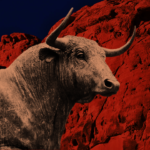 Earth (sit-an) Represented by orange, the ox/bull, and the stonewood tree (similar to ironwood), the element of earth is embodied in the Spirit Race known as sitani. The sitani are associated with stone, soil, and durability. Along with the afa and argenti, the sitani are highly revered by farmers. They appear as stocky humans with stone skin, and are also revered by builders and Scribes (wizards) who rely on earth or stone for their crafts.
Earth (sit-an) Represented by orange, the ox/bull, and the stonewood tree (similar to ironwood), the element of earth is embodied in the Spirit Race known as sitani. The sitani are associated with stone, soil, and durability. Along with the afa and argenti, the sitani are highly revered by farmers. They appear as stocky humans with stone skin, and are also revered by builders and Scribes (wizards) who rely on earth or stone for their crafts.
The earth metal, tin or sitanum, is a metal that is somewhat useful in creating tools, but primarily useful in combining with copper/kupurum to fashion bronze tools. In some regions, it is used as the least-valuable precious metal.
The pure stone, sitite, is a strong, orange-brown building material that is hard to work. The stone gem, anbe or topaz, is an orange jewel.
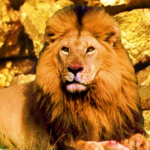 Metal (aur-um) Represented by yellow, the lion/tiger, and highly valuable goldwood tree, the element of metal is embodied in the Spirit Race known as auri. The auri are strongly associated with wealth and social power, and considered closely allied with the sitani and kupuri in fostering prosperity, civilization, and creation just as the ferei are considered allied with tia and afa in loss and destruction. They appear as golden-furred or golden-skinned humans.
Metal (aur-um) Represented by yellow, the lion/tiger, and highly valuable goldwood tree, the element of metal is embodied in the Spirit Race known as auri. The auri are strongly associated with wealth and social power, and considered closely allied with the sitani and kupuri in fostering prosperity, civilization, and creation just as the ferei are considered allied with tia and afa in loss and destruction. They appear as golden-furred or golden-skinned humans.
The pure metal, gold or aurum, is a precious metal, five times more valuable than silver/argenitum and twenty-five times more valuable than copper/kupurum.
The metal stone, umsite, is a yellowish building material easier to work than ansite, and thus very highly prized. The metal gem, aurbe or agate, is a yellow jewel.
Chronicle Stones
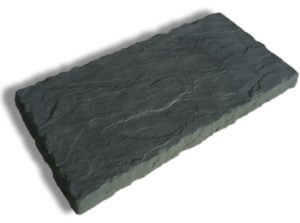 A key element of the setting are chronicle stones, magical slabs of carved rock that contain recorded knowledge. These stand in place of scrolls and codices, bound stacks of paper we commonly call books., although books are technically textual works that can be recording in a variety of formats.
A key element of the setting are chronicle stones, magical slabs of carved rock that contain recorded knowledge. These stand in place of scrolls and codices, bound stacks of paper we commonly call books., although books are technically textual works that can be recording in a variety of formats.
Each chronicle stone is about one inch thick, ten inches tall, and eight inches wide, like a thick sheet of standard printer paper. They weight around 20 pounds each, and are thus costly to carry.
Chronicle stones display written language for literate men and spoken language for all women. Some gamers might feel this represents archaic gender standards, but Haya is an archaic setting that attempts to capture archaic verisimilitude within a fantasy setting. Individual gaming groups should feel free to modify the rules on chronicle stones to fit their sentiments, for male and female and homosexual and transgender characters, however they feel creates an engaging and open game setting.
Types. Any female or literate male (full literacy is quite limited, perhaps 2 percent of the population) can access the information in a chronicle stone. However, the class who primarily copy or write chronicle stones are called Scribes—basically a wizard in the d20 System. The limits on the Scribe class are discussed in the race and class descriptions below. In addition to Scribes, Priests (clerics) can copy or write a certain type of chronicle stone called writings, Poets (bards) can copy and write a type of chronicle stone called anthologies, and Traders (homebrew) can copy and write a type of chronicle stone called ledgers. Only Scribes are able to copy all types of chronicle stone.
While accessing chronicle stones is open to all women and literate men, copying requires level 1 of the Scribe, Priest, Poet, or Scribe class. Writing new chronicle stones, or writing new information to existing chronicle stones, is an ability gained generally by these classes at level 11, but available to Traders at level 1, who have a very close relationship to their ledgers. Referees (dungeon masters) should make the copying and writing of new chronicle stones quite costly, since it is essentially the creation of a magic item.
Each chronicle stone represents a single book, the most prestigious of them being classic works. Some books are closed, meaning that no new information can be added, while others (called chronicles or ledgers) are open to new entries.
Closed books include histories of specific events or periods, studies of specific knowledge, anthologies of songs for Poets, and collections of religious chants for Priests and arcane rituals for Scribes called writings. Most closed books were written by a single author, and are identified by that author’s name, but a few are collaborations by several authors.
Open books record ongoing activities. Chronicles are used to record things like the genealogies of important families, ordinations of priesthoods, or events in a certain city or region. Ledgers are the personal records of Traders, used to keep track of details about people traded with, where goods are found, how much they’re worth, and of course individual trades, purchases, and sales. Each Trader is granted a ledger by his/her mentor at Level 1, and they can make archival copies in case the original ledger is lost.
Access. The text of every chronicle stone can be accessed either visually or aurally.
The visual displays of chronicle stones take the form of carved characters that appear on the stone’s surface and can be manipulated by touching individual characters, much like modern real-world people tap icons on a smart phone. There are two forms of writing, the primary one a hieroglyphic-like logography of symbols developed by the ancient Damdilit, which represent individual words/concepts (called the thoughts), the secondary one a phonetic alphabet of simplistic marks representing vocalizations (called the sounds), developed by the ancient Yuta.
The visual content of chronicle stones are accessed by literate men, primarily Scribes, Priests, Poets, and Traders.
The aural content of chronicle stones also takes two forms. The primary form (which is the only one available in older books) is the stone languages, the four archaic tongues of the Adya, Agtile, Damdilit, and Yuta peoples. These three languages are still spoken as a sort of quadruple lingua franca among Scribes and the aristocratic classes of the civilized peoples. The secondary form, in more recent books, are in the languages of current era. But, even these more recent books also contain a stone language translation.
The aural content of chronicle stones are, as said, accessed by women speaking to the chronicle stones, which also speak in response, in the voice of the original author and translators.
Chronicle stones can be the stepping off points for adventures. Histories can give clues to treasures to be won and mysteries to be discovered. Studies can provide information that can lead to new knowledge. Writings provide spells for Scribes (wizards) and Priests (clerics). Anthologies can provide spells for Poets (bards).

